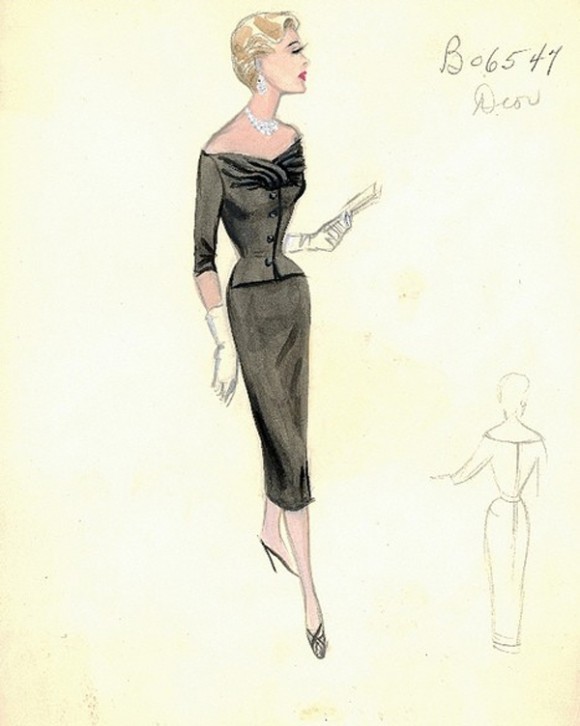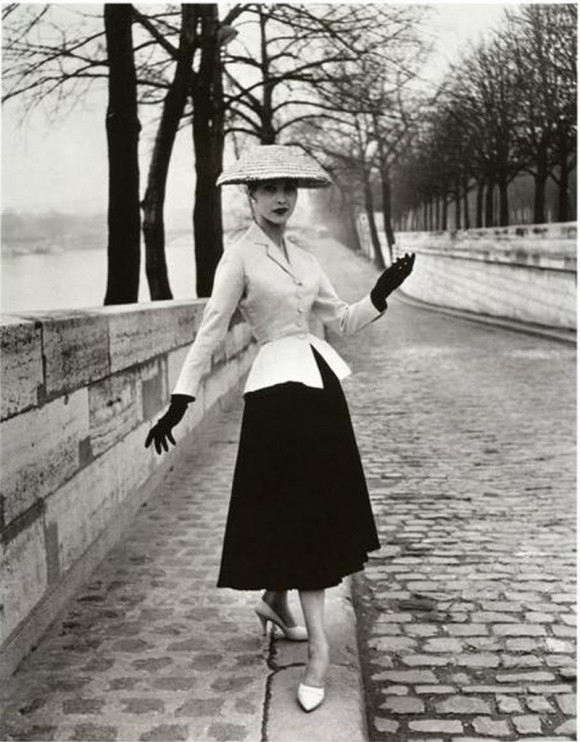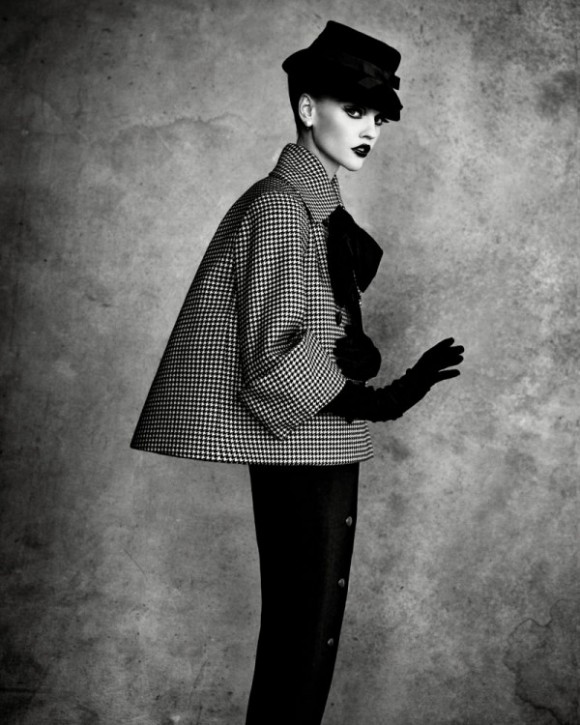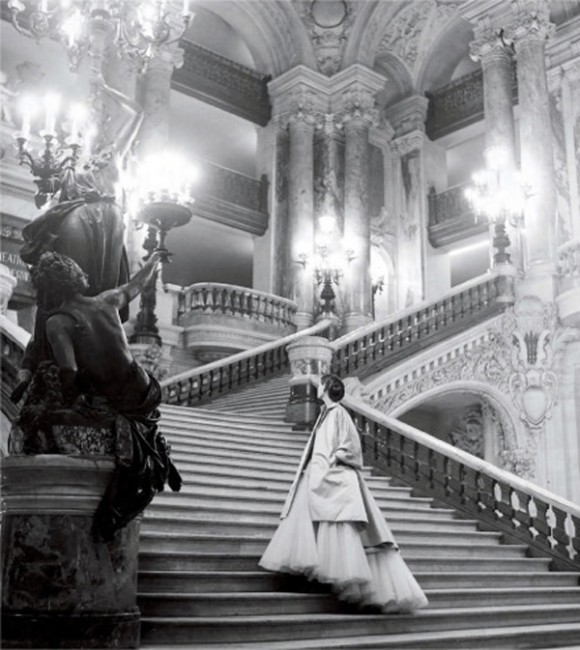Lately, I’ve been thinking a lot about ease. In fact, I wrote about it recently in my column for Sew News and thought I’d talk about it a little bit here, too. And since I received this beautiful book on Dior, published in conjunction with the exhibit at the Musée Christian Dior in Granville France, I thought it might be fun to illustrate this post with images of Dior’s designs. I’ll explain shortly.
First, ease. There are two types of ease: wearing ease and design ease. Everything you wear has some sort of ease to it, thus the term “wearing ease.” Any garment needs to be a little wider than you are so you can breathe and move and be comfortable, even in very fitted garments. (With knits and stretchy fabrics, the ease happens naturally because of the stretch and give of the fabric, so some knits will actually have negative ease–meaning that the width of the garment is narrower than you are. But let’s save that discussion for another blog post, shall we?)
Different people may prefer different amounts of wearing ease, but everyone requires some amount of wearing ease in their clothing. For example, let’s say you and I are both the same measurements and we both want to wear the same fitted dress. (Maybe we’re dressing as twins, I don’t know. Just pretend, OK?) Anyway, we may find that you prefer the dress to be tighter or looser than I do, even though technically we’re the same. But in general, wearing ease allows a minimum of 1/2″ (at a waistband) and a maximum of 2″ (at the hips) of extra room in a garment. It’s vital that you have room to move and breathe, so wearing ease is a necessity.
Design ease, on the other hand refers to the additional room in a garment. This is truly more of a design detail, intended to give a garment a particular silhouette and fit. And this is where I think a lot of women, especially women who are just starting to sew for themselves, get tripped up.
In my experience, a lot of women seem to think that design ease is the same thing as a bad fit, or an unflattering fit. Believe it or not, design ease can actually work to your advantage! Tight or fitted clothing can be less flattering than clothing that has a little more room in it. I use design ease to my benefit all the time; my lower half is wider than my upper half (in other words, I’m “pear shaped”), so I use design ease to balance myself out. (I can talk more about how I use design ease in my own wardrobe another time, if you’re interested.)
The word “silhouette” is basically just a fancy term that refers to the shape of clothing and how it defines the shape of body. By adding volume, we can change how the body is perceived. More volume (i.e., more ease) can either emphasize or draw attention away from a particular part of the body depending on how that volume is used. Different body shapes will be better suited to different fashion silhouettes. But since there are lots of ways to use design ease to create balance, don’t let yourself get trapped into thinking just one silhouette works on your body. If you’re broad on top or don’t have much of a waist, a looser fit that skims your body can actually be more flattering than something with little design ease that hugs your curves. The key is balance. You might find that you can wear a loose tunic with lots of design ease if you pair it with leggings or skinny jeans. Or maybe you wear a fitted top with wide-legged trousers. In most cases you won’t want to add volume everywhere, but it can work to your favor if you use it well.
Even M. Dior, the emperor of the fit-and-flare, wasp-waisted New Look, used design ease in a variety of ways. I love the A-line jacket in the third photo. He balanced the volume of the jacket with a very slim skirt. Dior had a lot of fun with volume and ease in his designs and didn’t restrict his work exclusively to the wasp-waisted look, even if that’s the silhouette for which he is best remembered.
So when you find a particular silhouette that suits you, play with it! And don’t be afraid to try other silhouettes, too. You may very well be surprised at what works for you.




I would be interested in more information about how you use design ease. This kind of information is very helpful. So much of what I find is technical–and that’s good–but I value the “big picture” as it relates to personal sewing.
i love this post, liesl!!! yes i’d love to see more about how you use design ease, and maybe also a post of how you play with proportion in your own dressing? as a fellow pear (but a much shorter one than you) i default to a fitted top and flared bottom, though more recently i’m learning i can do flowier up top with leggings/skinny jeans as long as the neckline is more open – otherwise i feel swallowed up. you seem to be a master at proportion in your patterns and in your own dressing, though, so i’d love to learn more. 🙂
I am with Mary, I’d be very interested in hearing about your experiences with design ease.
I would be interested to hear more about how you use design ease, too. I’m stuck in a very safe fashion rut, wearing more or less the same silhouette every day.
The a-line jacket is killer, but how on earth does she walk? It’s the perfect outfit for standing still! 🙂
Very interesting, and yes, please write more on the subject! I try to consider design ease when making adjustments to a pattern, so for example I might make a slight FBA even on a looser-fitting garment where I could get away without it – otherwise it won’t fit as it was meant to, because I’d be using up some of the intended design ease as extra wearing ease.
Yes please, I would love to see more info on how you use design ease in how you dress 🙂
Such a wonderfully explained blog! As my body shape has changed over the years I have felt less comfortable in choosing designs appropriate to my shape. My problem was exactly as you described! I would love to hear more on the topic Thank You!!!!!!!!!
Thank you for such an informative post! I too would love to hear how you use design ease in your own wardrobe.
Wonderful pictures. You must be thoroughly enjoying your new book and thanks for sharing them with us. I so enjoyed your post on ease and would love to hear more about how you have used ease in working up your wardrobe. I am just getting to the point in my sewing where the fit details are becoming something to really address.
I’d love to hear more. I have sewn almost exclusively for my children but I’m trying to commit to sewing for myself. I’m fussy about how my clothes fit and would love to gain the knowledge to make garments that work for me. I’m especially interested in the link between design ease and fabric choice. Quilting cottons may be great for a little-girl dress but less so for a full skirt for a grown up!
Such an interesting post (plus great eye candy!). I would LOVE more info on how you use design ease….. pretty please!
Reading above, “(I can talk more about how I use design ease in my own wardrobe another time, if you’re interested.)”…
Did this post get done? I’d love it!!! It would really help as I’m revamping my style/fit, and trying to decide about ease.
Rebecca, it hasn’t been done…yet! But I promise I will get to it just as soon as I finish this book. It’s something I’m passionate about and really want to help others with. Stay tuned, ok? xo
I have struggled with this my whole life. I hate anything tight or formfitting. Finding clothes with a lot of design ease is not easy. Hence, up the size until it fits the way I want. As to sewing for myself, if I could find the fabric I wanted and the pattern just so, maybe. I’m sticking to the grandgirls right now.